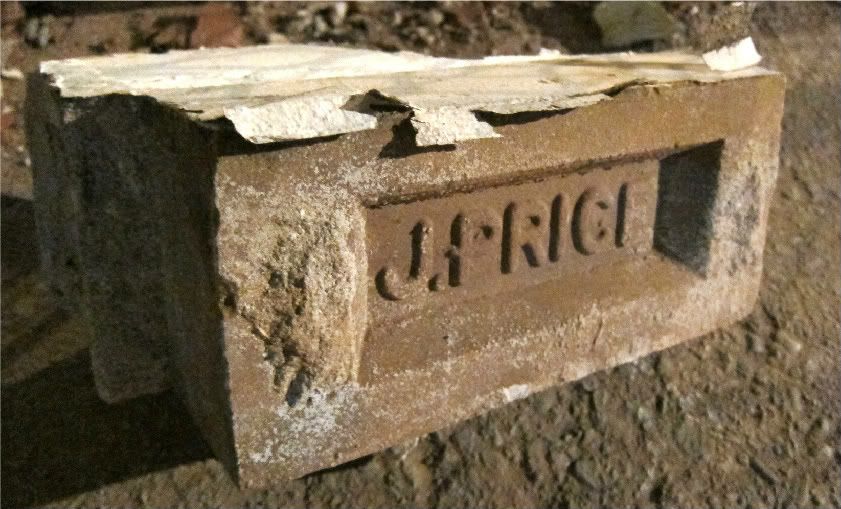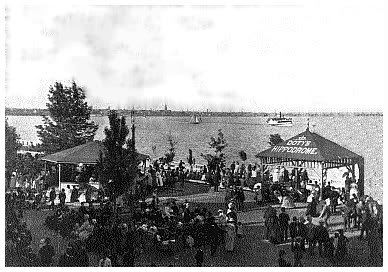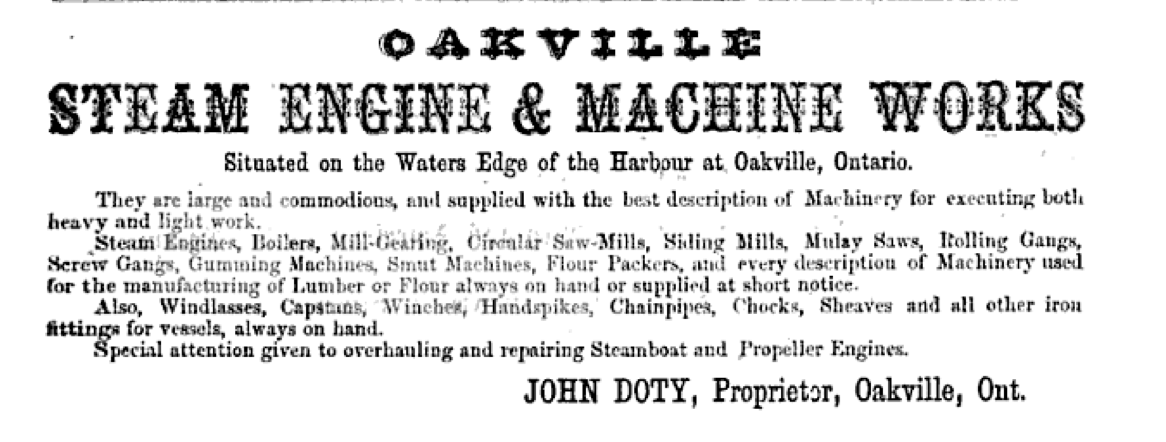John Doty was the man who built the industrial structure we know today as the Rock Oasis.
Doty was an energetic, ambitious, and thrifty machinist with many interests, whose formidable business acumen guided him to success in Toronto. He ultimately controlled several overlapping enterprises involving: engine and machine works, shipbuilding, ferry operations, and amusements on Toronto Island.
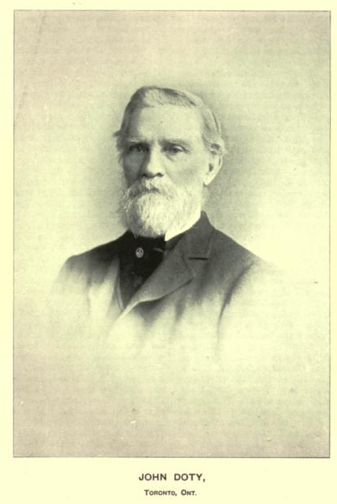 |
| From Prominent Men of Canada, G. Mercer Adam |
Born on a farm in the township of Lewiston, Niagara county, New York in 1822, John Doty had a lineage that traced back to Edward Doty, one of the original Mayflower pilgrims of 1620. He was the second youngest child out of seven. He learned the machinist trade from Mr. Lewis Kenyen in Rochester NY at the age of 16, and four years later moved to Niagara Falls.
Stints in Toronto, Oakville, and Hamilton followed, and at each step Doty took a larger role in business affairs, eventually selling his firm in Hamilton in 1872. In 1875 he moved back to Toronto. He started a machinery shop at the foot of Yonge street, on the west side of the slip, but eventually outgrew those premises.
He then purchased property at the foot of Bathurst, on the west side -- from the Masseys, in 1883.
This western lot was previously occupied by the Dickey, Neill and Company Soho Foundry, which operated from 1875 to 1877, after which the premises were taken over by the Toronto Reaper and Mower Co. This company was then acquired by its rival, Massey Manufacturing Co. in 1881 (Massey would later become Massey Harris, Canada’s largest manufacturer of agricultural implements and Toronto's leading employer, at a famous complex of factories further west on King).
The view from the original west-side machine works: Doty eventually moved across the street to expand
|
Doty commenced operations therein for a large machine works (presumably it was around this time that he lived in the John Dunn house). This machine works was also previously depicted in the 1884 Goads Insurance map. Structural remains of this building can still be seen physically, in the lot at the foot of Tecumseth on the south margin of the property.
 |
| 1890 Goads Insurance Map showing Doty's Machine Works - on both sides of Bathurst |
The Doty Engine Works
Once more, Doty’s business outgrew the premises, and with the intent of moving, he purchased new property on the east side of Bathurst, just above Front street, shifting operations sometime around 1889.
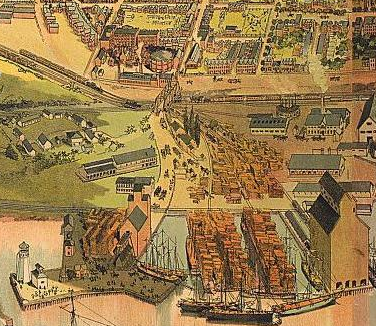 |
| 1893 Chromolithograph excerpt, Barclay Clark & Co. |
Take a look at this massive -- not to mention gorgeous -- 1893 Chromolithograph of Toronto by Barclay, Clark & Co. Expand it to its full size, and you'll see that the familiar warehouse shape of Oasis appears to have already been built! But where is the tower? And where is the Rescue Inn?
Doty’s machine works on the west side of Bathurst are also visible.
Unfortunately, it was common practice in drawings like this to include structures not yet constructed, as well as prospective buildings. (Observe City Hall (then new, now old)'s presence -- yet old City Hall was built in 1899.) So the date isn't quite as reliable as you might think.
 |
| The 1891 Assessment Roll showing Doty and sons' presence on the east side of Bathurst. Of note: Doty is 68! |
The ‘1 story’ entry in the above Assessment Roll indicates the total Works structure -- the length (200 feet) and value support this interpretation. Does the ‘3 story’ entry represent the tower, or is it the Sherwin Williams building to the north?
There is no listing for Doty on the east side in the 1890 Assessment; this fact, taken together with the 1890 Goads map and a similarly new entry in the 1891 Might’s city directory, suggests that the east side Bathurst Doty Engine Works were constructed in late 1890.
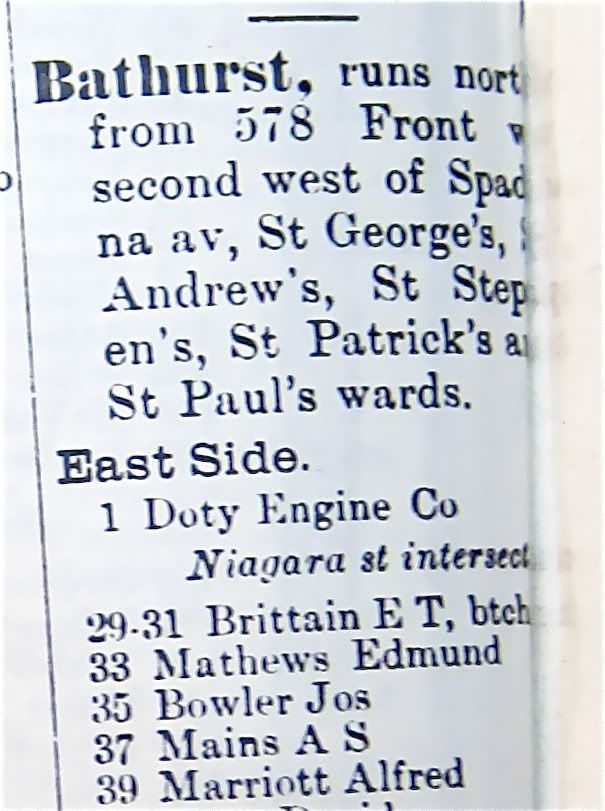 |
| 1891 Might’s Directory - Doty’s first listing on the East side of Bathurst |
Doty prospered in his new spot on the east corner of Front and Bathurst, where the Rock Oasis climbing gym would eventually be built. The location proved to be the launching pad for Doty's sizeable business empire. Doty built all kinds of machinery, and for any purpose.
Here’s a multi-page advertisement for one of Doty's products, built and sold at Front and Bathurst:
The Doty-Vertical Steam Engine and Boiler
(Advance the pages to see the full description, more prices, and other products sold by Doty!)
"A man with a technical knowledge and who is a good mechanic is a better man than a mechanic without a technical knowledge… Men who have not a technical knowledge are only equal to inferior men."
- John Doty
In January 1888, Doty was called before the Royal Commission on the Relations of Capital and Labor in Canada.
There, he was asked to testify on the importance of technical education. Doty's testimony provides a riveting glimpse into the working conditions that prevailed at his Machine Works over one hundred years ago.
The interview, reproduced below, is highly recommended reading (it's only a couple of pages long, and it starts near the bottom of page 326). At this point in time, Doty managed over 100 employees at the Works, ranging from unskilled labourers to highly adept machinists.
If you ever wondered whether the staff at Oasis were underpaid, imagine working fifty-seven hours per week, ten hours a day during the week, and working till 4 on Saturdays… making $2.25 a day as a senior machinist!
Doty's Machine and Engine Works, and the expansion of the railroads south of Front Street, changed the character of the Wellington and Niagara neighbourhoods. Industry became the accepted norm in the area; this was symptomatic of how Victorian Toronto divided itself into more clearly defined residential, commercial, and industrial districts. A side track from the Grand Trunk Railway ran directly to Doty's premises, enabling the company to receive material from any part of the continent, and to load and ship machinery to all parts of the country.
 |
| The building permit for Doty’s foundry. This was the closest I came to finding the permit for the Engine Works, which were constructed a couple of years earlier. |
The Doty Shipyards
Yet engines and machinery were merely the foundation for the striving industrialist. The John Doty Company (John Doty and Sons) was the first ship building company organized in the Bathurst Wharf area. Formally declared in 1891, the company built a shipyard at the foot of Bathurst near the bay, occupying the Northern Railway wharf south of Portland [see the full 1890 Goads]. Between 1890 to 1893, Doty constructed these six vessels, keeping his machinists frenetically occupied:
- Mayflower
- Primrose
- Mistassini
- Garden City
- Petrel
- Medora
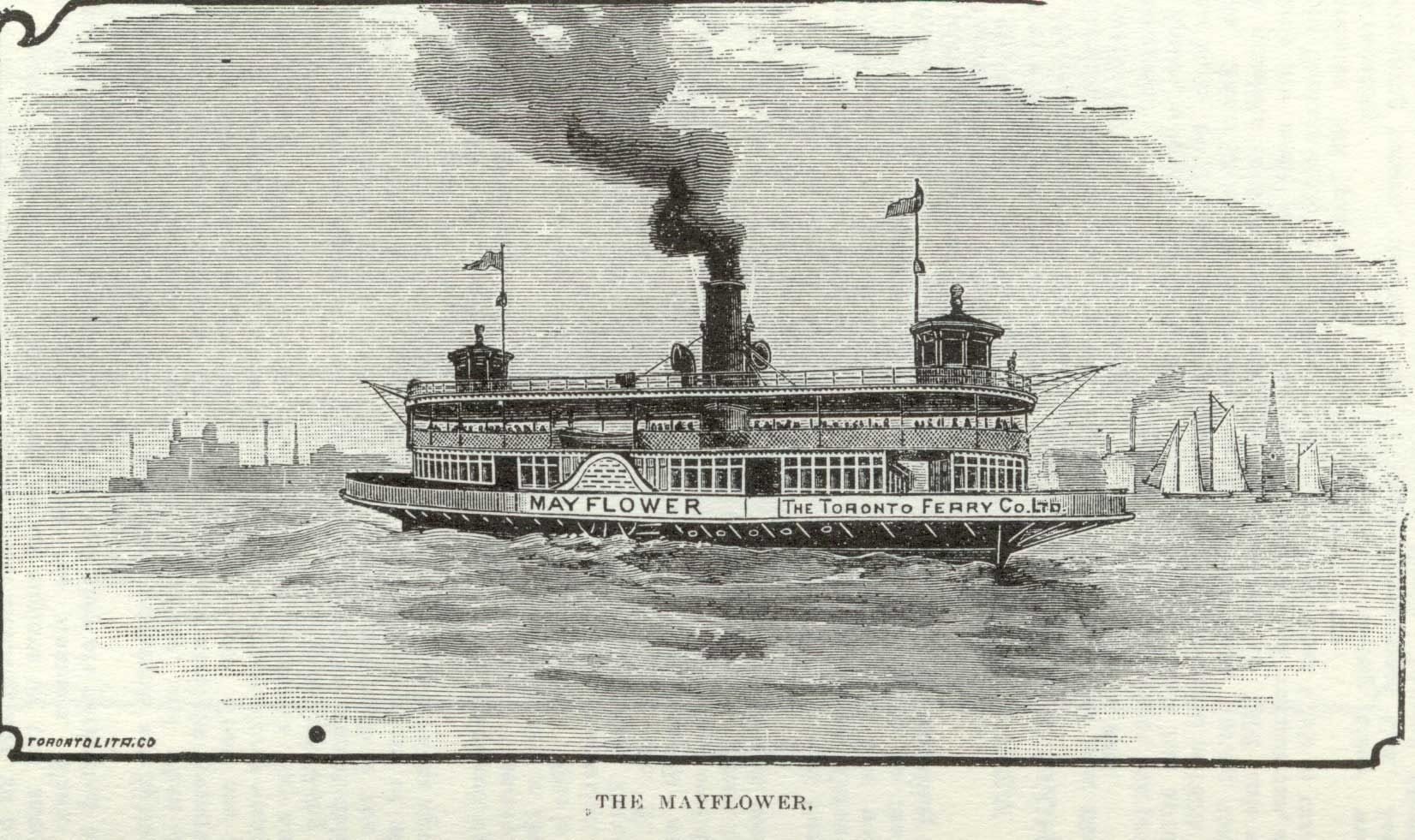 |
| A sketch of the Mayflower. Note the octagonal 'birdcage' pilot houses |
The Primrose and the Mayflower were identical sister ships designed by W.E. Redway, both launched at the Doty shipbuilding yard and used as Toronto Harbour ferries. At the time they were the largest-capacity ferries in the Harbour. The boilers and other parts for these ships were constructed, naturally, at the Engine Works. Both vessels lasted until 1938, when they were scrapped and rebuilt as work barges. Robertson's description:
"The Mayflower and Primrose, are sister ships, and are not only justly prized by their owners, but greatly appreciated by the general public. Their appointments are as nearly as it is possible for them to be perfection and every reasonable convenience is afforded their patrons. Their framework is of steel, their length just exceeds 140 feet and their breadth 28 feet. They are two-decked, double-bowed paddle steamers, and were built in Toronto in 1890 by the Doty Engine Company. They each possess two diagonal direct acting 29 horse power condensing engines by the same company as built the steamers [Doty]. Their tonnage is 189.40, and they are permitted to carry 900 excursionists."
- Robertson’s Landmarks, Volume 2
"Both these steamers are lighted throughout by electricity, and when loaded with pleasure-seekers at night present a gay and unique appearance. They are universally considered the finest ferry steamers to be found between Hudson's Bay and the Gulf of Mexico. One pleasing thing in connection with them is that almost daily throughout the season hundreds of the inmates of the charitable institutions of the city are provided with free excursions upon them by their proprietors."
- Toronto Telegram
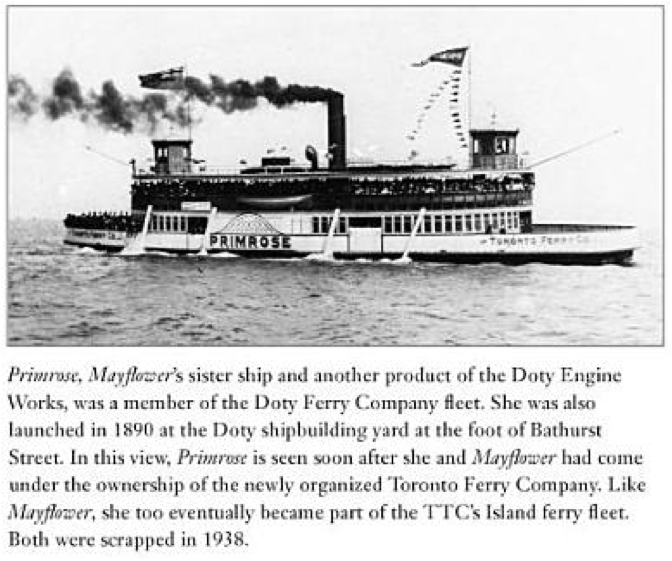 |
| From Mike Filey's Trillium and Toronto Island: The Centennial Edition |
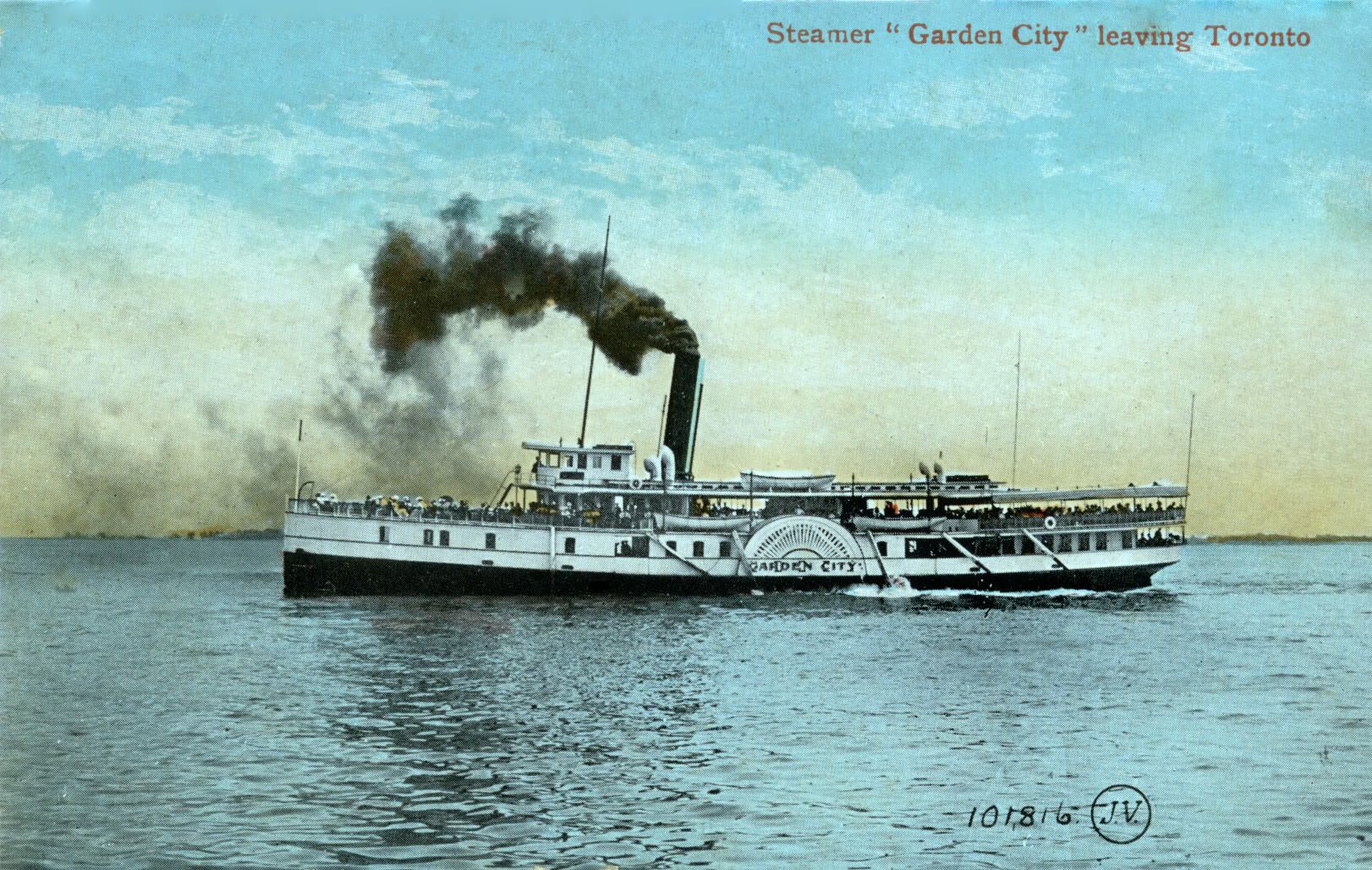 |
| Postcard of The Garden City |
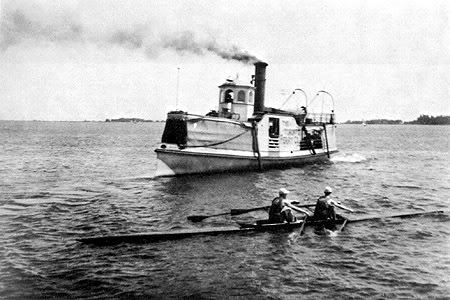 |
| The Luella (the angle in this photo makes the vessel appear stubby). Note the canvas curtains, usually dropped in inclement weather. The octagonal pilothouse was eventually removed in a 1908 refit. |
The Doty Ferry Service & Island Amusements
Doty's ferry construction went hand in hand with another focus of his -- ferry operations and Island amusements. In the late 19th century, two ferry companies were predominant: A.J. Tymon's Island Ferry Company and the Turner Ferry Company.
Doty purchased the Turner assets in 1887 for $14,600 (John Turner had passed away) to form the John Doty Engine and Ferry Company. Doty controlled the wharves at Yonge and York, as well as the wharf at Hanlan's point. With his sons, Doty ran and operated the Toronto Harbour ferries for about five years.
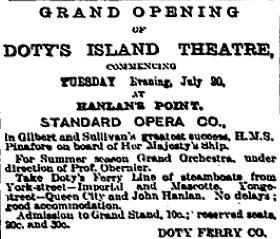 |
| From The Globe, July 17, 1886 |
Imagine -- a patron of this theatrical showing of HMS Pinafore would sit in a theatre built by Doty, having taken the ferry service operated by Doty to arrive there, using a ferry built by Doty, with a thrumming Doty engine at its heart! An audacious example of Victorian vertical business integration, to be sure.
 |
| Doty Ferry Lines at Hanlan Hotel on the Toronto Island, sometime between 1885-1895 |
 |
| Lawrence "Lol" Solman, general manager for the Toronto Ferry Company. From Trillium and Toronto Island, Mike Filey |
In 1890, Doty's company was merged with the Tymon operation to form the Toronto Ferry Company, a joint stock company capitalized at $250,000. The Toronto Ferry company under general manager Lawrence Solman is notable for constructing (presumably with Doty's knowledge as a shareholder in both the TFC and the Island Amusements Company) an amusement park in 1894 at Hanlan's Point, as well as the adjacent Hanlan's Point Stadium in 1897 for the Toronto Maple Leafs baseball club. [Babe Ruth would hit his first professional home run into Lake Ontario from a later incarnation of this stadium]
The ferry license of the Toronto Ferry Company would go on to be acquired by the Toronto Transportation Commission (1927-1954), which morphed into the Toronto Transit Commission (1954-1961). The license was subsequently held by the Metro Parks Department (1962-2001). The Island ferry service is now run by the Toronto Parks Department (2001-present).
Doty's mini-empire would not last. In the early 1890s he "suffered reverses in the hard times that followed the boom" (there was a major world industrial slump in the 1890s), and his business encountered financial duress.
In late 1892, the Doty Engine Works and shipyard were sold to its major creditors George and John Bertram, and Doty 'retired' and moved to Goderich. Two of his sons, Frederick and Franklin, stayed on to manage the Works for a time, notably building a sand pump, before eventually joining their father in Goderich (the Doty Engine works in Goderich was where one of the first pile-drivers was designed) (Another son, Albert, lived in NY).
A Doty Steam Engine from 1895 (Goderich) can still be found in active use today. The S.S. Pumper is a meticulously restored wood fired, steam screw vessel situated at Fort George on the Niagara River.
At its peak, Doty's various enterprises employed up to 300 people. Doty passed away in 1902, and had three surviving sons by his wife of sixty years, Louisa Jane Wilcox.
 |
| From The Daily Star, Sept 30, 1902 |
It would take two men -- the Bertram brothers -- to follow in Doty’s accomplished footsteps. These brothers would themselves prove worthy successors as forthright men of industry...
Read the next section:
You’re reading: Farewell to Rock Oasis, the secret history of my home climbing gym.
Table of Contents
Like, Share, or Comment on this post!
Secret Bonus material
Click here and here to read a April 23, 1887 article in the Globe regarding Doty’s "Ferry Monopoly"
An ad from Doty’s years in Oakville:
An ad from his early tenure near the Esplanade:
Doty’s sons Franklin and Frederick continued to operate in Toronto for several years after the retirement of their father under the name “Doty Brothers & Co”, with an engineering works location at the St. James Hotel building on York St., east side between Esplanade W and Front St. W (opposite the east end of Union Station):
 |
| Photo taken 1896 courtesy Toronto Public Library: public domain. Baldwin room B 12-15b |



